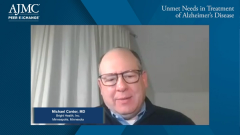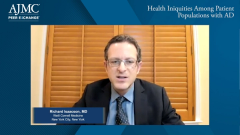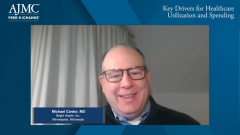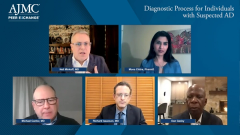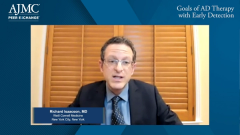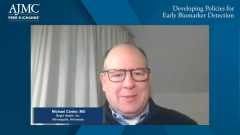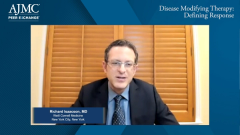
Improved Tracking of AD Comorbidities and Progression
Expert panelists discuss methods to better monitor comorbidities and adverse effects associated with Alzheimer disease.
Episodes in this series

Neil Minkoff, MD: As we move to disease modification, we will need to get to these other outcomes, whether it is cognition, functional MRI [magnetic resonance imaging], or serial MRI. What are some of the things we could use? I am pushing toward the pathophysiology, the beta cascade, the amyloid beta cascade. Are those things that we should be measuring and following?
Richard Isaacson, MD: These are important questions. From a blood pressure perspective, if we are trying to focus on that, looking at white matter disease, white matter hyperintensities, the white spots that show up on the brain MRIs on the T2 [transverse relaxation time], the FLAIR [fluid attenuated inversion recovery] images, for example, this basically shows that the person probably has evidence of vascular disease in the brain. Tracking that over time makes sense, but where are the tools to detect that? Where are the automated volumetric tools? Where are the automated tools to detect that your white matter disease has stabilized over 2 years? We do not even have the software to do that kind of stuff. When it comes to amyloid scans in the brain, I would love to do serial amyloid scans. In our major study, we could only afford amyloid scans at the beginning, to classify people. Honestly, the fidelity of these scans sometimes is not perfect.
With where we are going with our field, I hope that, within the next 2 to 3 years—which is a bullish estimate and aggressive, hopeful statement—just like we get cholesterol blood test results with the HDL [high-density lipoprotein] and the LDL [low-density lipoprotein] and whatnot, I hope that, 2 to 3 years from now, we are going to get the serum amyloid levels, the serum tau, maybe an NFL [neurofilament light]. We are going to get these, and we are going to track brain biomarkers in the blood just like we do in cholesterol. People may hear this and say, “That is science fiction, that is crazy talk, and that is not going to happen.” It is going to happen.
It is going to happen just like Alzheimer disease prevention was crazy talk, and people threw tomatoes at me back when I gave my first lecture on the topic in 2007. I am not going to go into who threw them. Some former presidents and neurologists may have been giving me the eye rolls, but anyway, I took it and carried on. Honestly, it takes 10 to 15 years.
Neil Minkoff, MD: No wonder you like these virtual discussions.
Richard Isaacson, MD: Yes, they are much better. I have no shield, and I do not have to block myself from tomatoes. It takes 10 to 15 years for something proven in science to be translated into clinical practice. We have to cut down that down, even if it is by 2 years, 5 years, or even 7 and a half years. We have to fast-forward the research, and we have to get the payer systems to appreciate the power of prevention.
Neil Minkoff, MD: Could we use that to harness early detection? What would be the ability to work backward up that cascade to say at what point we should be screening people with an MRI, for example?
Richard Isaacson, MD: It is a controversial answer but as early as possible. We [at Weill Cornell Medicine] started the clinic, and we were seeing people age 40 and above, and I thought that was aggressive. I then had a 32-year-old patient who wanted to see me because I was treating his mom with Lewy body dementia mixed with Alzheimer disease. Still to this day, I do not know exactly know what it is, and I decided to see him at 32. He had the APOE4 gene, and he performed way lower than he should have on the cognitive assessments that are meant for preclinical diagnosis. We then kept lowering the bar. I saw a 25-year-old a couple years ago. I thought that was too young. I saw that her mom had symptoms at 52. If you take 52 and you subtract 20 to 30 years, I should possibly be seeing her at around 25 to 35 years old.
We need to go early, and we need to understand a person’s trajectory: what their pulse is, what their blood pressure rate is, what their baseline cognitive function is using computer-based cognitive tests. We can get a baseline MRI. I am not sure if it is too early at 25 or 35 years of age. I do not know the exact right answer. Digital biomarkers are a way of the future because they are lower cost. We slap these wrist devices on people and track all these different things. I wish I had all the answers here, but this is complicated.
Neil Minkoff, MD: Sorry I cut you off a second ago, Mona.
Mona Chitre, PharmD: That is OK. I was thinking that this is going to take all of us: the experts in the field, the primary care providers, the hospital administrators, the employers who set the benefit designs and talk about affordability, our Medicare members, for whom cost and fixed income is important. As I was listening, I was thinking that what we did not talk about, Neil, as one of the levers that we use are our ACOs [accountable care organizations] and our value-based payment systems. We have moved in the last 5 years, I would say, from pay-for-production to pay-for-performance, getting to paying for keeping our patients, our members, and our communities healthy.
Perhaps over time, Alzheimer disease, mild cognitive impairment, and brain health can be something that is measured similarly to cholesterol, mental health, and diabetes. The key will be, as Dr Isaacson mentioned, what are the simple, perhaps not straightforward, but 1 or 2 measures that we can think about that we put in our ACO system? That includes neurology, geriatrics, and primary care, to start talking about this early, as opposed once patients have already become symptomatic.
Transcript edited for clarity.
Newsletter
Stay ahead of policy, cost, and value—subscribe to AJMC for expert insights at the intersection of clinical care and health economics.

